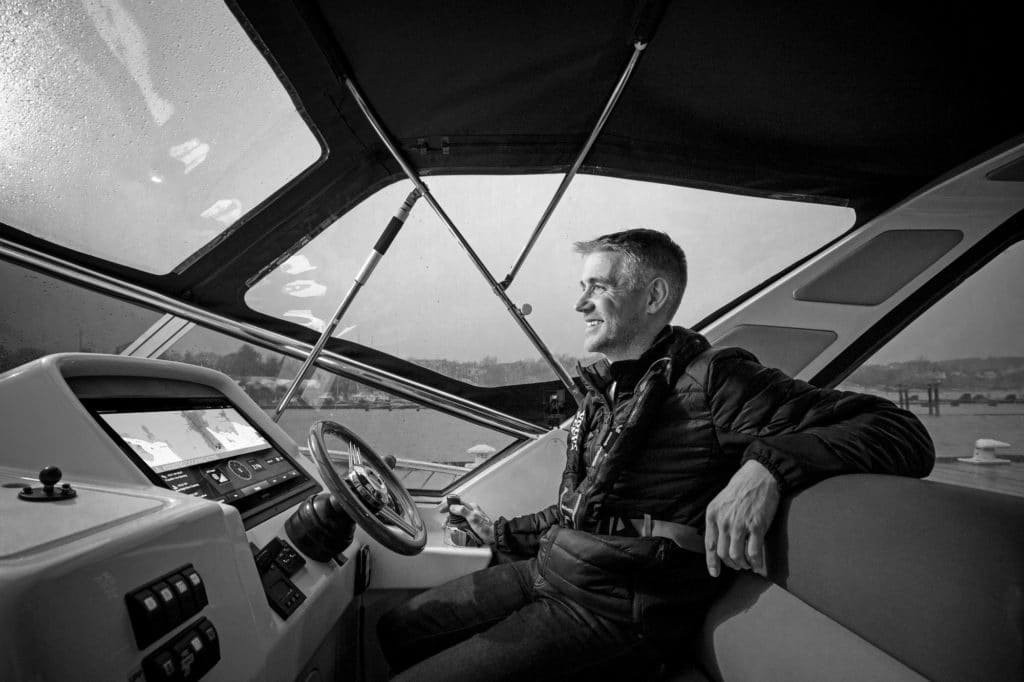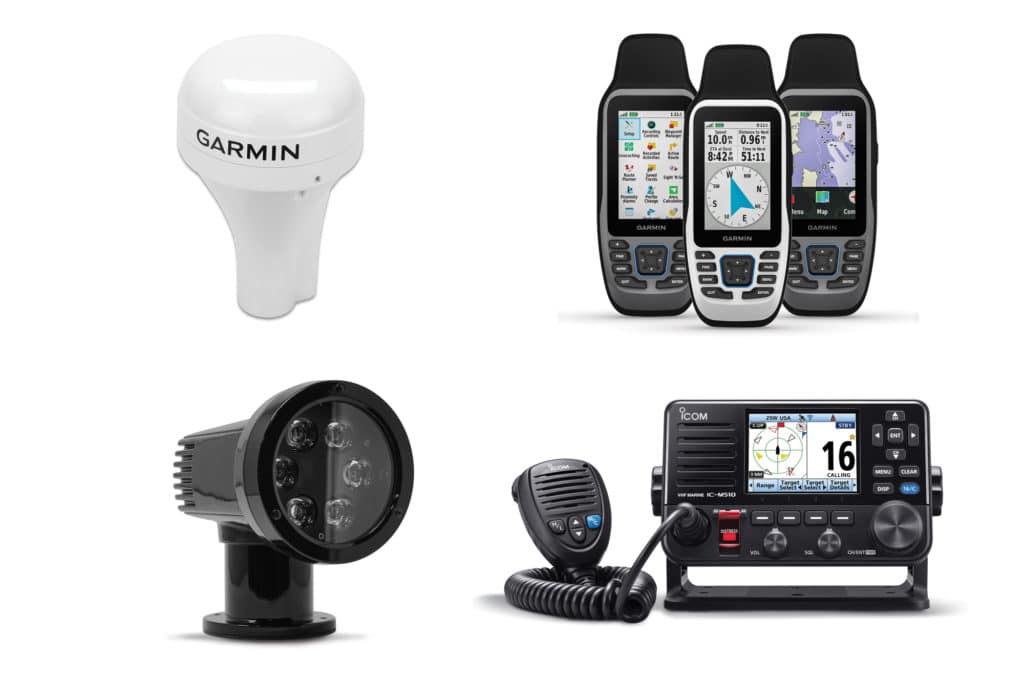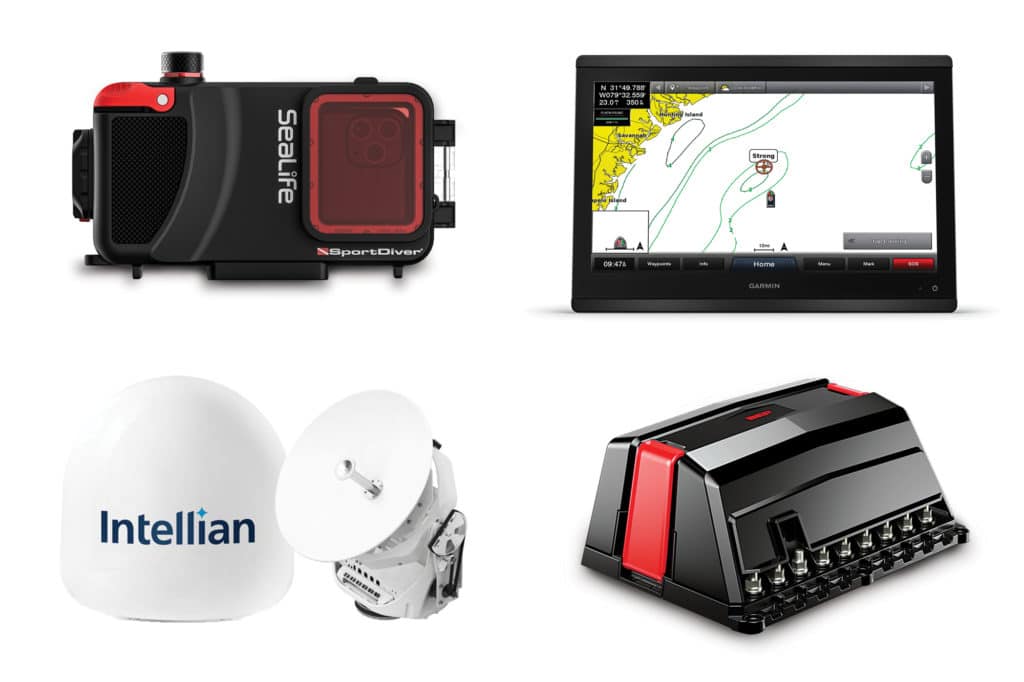
The past few years have been challenging. The good news, however, is that a nautical sabbatical can help. Whether it’s for a few days or a trip around the sun, some recently launched communications, navigation and networking equipment can boost situational awareness, lower stress and improve the onboard experience.
Communications
VHF radios have long been the go-to technology for marine communications. But sometimes their user interfaces can feel clumsy when compared with touchscreens. Enter Icom’s M510 series (from $600). These fixed-mount VHF radios are the first from a mainstream manufacturer to give users command and control over systems using smartphones and a dedicated app. All M510 radios have built-in digital selective calling and NMEA 0183 compatibility; users can upgrade to NMEA 2000 compatibility with a CT-M500 black box. The IC-M510 AIS has a built-in AIS receiver.
The Intellian v45C is a very small aperture terminal (VSAT) antenna that employs an open contract. The v45C ($18,000) has a compact 45-centimeter antenna, making it Intellian’s smallest VSAT system. However, it offers data-transfer speeds typically found aboard a system with a 60-centimeter antenna. This smaller size (a v45C’s radome measures 24-by-24.6 inches) allows it to be fitted aboard yachts as small as 45 feet length overall. A single radio-frequency coaxial cable connects the v45C’s antenna with its belowdecks rack-mounted antenna control unit. A rack-mounted modem is also required, but this is supplied by one’s airtime provider. Each v45C uses three-axis stabilization to stay locked onto the right satellite in rough waters, and the open-contract structure lets owners choose airtime providers based on itineraries. As for speeds, a v45C that’s connected to, for example, an IntelsatOne Flex plan should deliver download speeds of 6 megabits per second and uplink speeds of 2 Mbps. Each v45C can support two or three cruisers and their paired devices.
KVH’s TracPhone V30 ($12,000) is a small, lightweight VSAT antenna that operates on an end-to-end network. The TracPhone V30’s radome measures 15.5-by-17.6 inches and contains a 37-centimeter antenna dish, with a ruggedized modem. The TracPhone V30’s radome weighs 23.4 pounds and uses 10 to 36 volts of DC power, making it suited for all-electric or DC-powered yachts (AC-to-DC converters are available). The TracPhone V30 is designed to operate exclusively on the company’s mini-VSAT BroadbandSM network, giving owners access to simultaneous tech support for hardware and network problems. The TracPhone V30 offers speeds up to 6 Mbps for downloads and 2 Mbps for uploads, and users can choose metered or unlimited airtime plans. Metered plans charge users only for the data they use at 50 cents per megabyte. Unlimited plans give owners a set amount of data at or near the network’s highest data-transfer speeds for a monthly fee (about $150 for 200 megabytes). Unlimited users aren’t charged for additional data use, but once they burn their monthly allotment, speeds are downthrottled.
Satcom systems work great, but the same ones and zeros can be transmitted for less cost via an onshore cellular network. KVH’s TracPhone LTE-1 Global ($1,700) allows users to connect to the internet in more than 150 countries from 20 nautical miles offshore, depending on their cellular coverage. The TracPhone LTE-1 Global’s high-gain dual LTE-A antenna arrays come bundled in a radome that measures 13.5-by-13.3 inches and weighs 6.5 pounds. As with all KVH products, customers buy airtime directly from KVH, providing one-call tech support.
While onboard Wi-Fi networks allow crewmembers and guests to connect to the internet with their personal devices, each connected smartphone, tablet and laptop represents a point of possible intrusion for a hacker. Firewalla Gold ($430) is a combination firewall, virtual private network, multi-gigabit router and network-monitoring tool for protecting data. It can also be used to block advertisements, provide network segmentation, and leverage administrative or parental controls.

Navigation
It’s always wise to pack ample lumens when navigating at night. ACR’s fixed-mount RCL-50 LED Searchlight (from $1,110) has a six-LED array that generates more than 100,000 candelas at peak luminosity. The RCL-50 has a 10-degree beam angle, and it can rotate through 360 degrees of azimuth and plus or minus 20 degrees of elevation. The searchlight measures 8.4 by 6 by 8 inches, weighs 7.72 pounds, and comes packaged in a marine-grade aluminum housing that’s triple-primed and sealed, making it ideal for tenders or for smaller to medium-size rides. Operators can control the searchlight via its remote control Point Pad.
For cruisers planning on wending through tightly packed archipelagos or rocky passages, confidence in positional accuracy is key. Garmin’s GPS 24xd ($300) has a multiband receiver that lets the sensor leverage the full global navigation satellite system, including the US-built GPS, the Russian-built GLONASS and the European Union’s Galileo constellations. The GPS 24xd reportedly provides positional accuracy to 3.28 feet, as well as azimuth information accurate to 3 degrees. The sensor is NMEA 2000-compatible and built to IPX7 standards. It updates at 10 Hertz and has multi-SBAS (satellite-based augmentation system) compatibility that allows the sensor to automatically correct for signal-measurement errors while giving users real-time insight into the accuracy and availability of incoming signals.
Vessels ranging from 35 to 120 feet length overall that are equipped with a Volvo Penta Inboard Performance System can add the company’s Assisted Docking system. Assisted Docking doesn’t require any external sensors. It instead uses Volvo Penta’s GPS-based dynamic positioning system antenna; the vessel’s IPS drive, steering, transmission and networked engine data; and a navigation system that supports Volvo Penta’s Glass Cockpit system. A human operator dictates the yacht’s speed and direction via the IPS joystick, and the system moves the yacht in a straight line as commanded. If a user releases the joystick, Assisted Docking holds the yacht in situ. Assisted Docking accounts for externalities such as wind, current and tide by updating the yacht’s position and heading several times per second. This information is fed to Volvo Penta’s electronic vessel control system, which fine-tunes the IPS direction and thrust. A banner on the yacht’s Glass Cockpit gives operators real-time information, including GPS signal strength, how much assisted power is being applied and a digital compass that displays direction lines. The system’s Side Push feature lets operators apply lateral force when docking side-to.

Operations
BEP’s Smart Battery Hub (starting at $2,000) monitors individual batteries’ real-time voltages and the full house bank’s state of charge, then shares this data with other networked instrumentation via NMEA 2000 connectivity. BEP makes the Smart Battery Hub for twin- and triple-engine rides. Both versions are compatible with 12- and 24-volt systems, and come with IPX7 water-ingress ratings and the ability to network with and be controlled by CZone digital-switching systems.
Few weather-forecasting apps are as powerful as those offered by PredictWind. These include PredictWind’s standard and Offshore apps, the latter of which works with satellite or SSB connections. Both apps give users access to different global and regional weather models, as well as PredictWind’s proprietary forecasts, rain and isobar maps, and weather-routing and departure-planning tools.
SiriusXM’s Fish Mapping can help anglers get on the fish faster and with less fuel expenditure. This subscription service requires a vessel to have a satellite-communications receiver and a compatible multifunction display. The system then provides a wealth of angling information, including fishing recommendations, sea-surface-temperature contours, plankton-concentration contours and plankton-front strengths.
Backup Navigation
Garmin’s GPSMap 79s ($300) comes with a global base map, while the GPSMap 79sc ($350) carries Garmin’s BlueChart g3 cartography. Both have screens that are 1.5 by 2.5 inches (200-by-400 resolution) and use AA batteries for up to 19 hours of navigation time.
Snorkeling with Smartphones
SeaLife’s underwater SportDiver housing ($300) allows Apple and Android smartphones to capture imagery down to 130 feet below the waterline. The housing has large buttons, and its built-in moisture sensor and companion app let users test the integrity of the housing’s seal.









